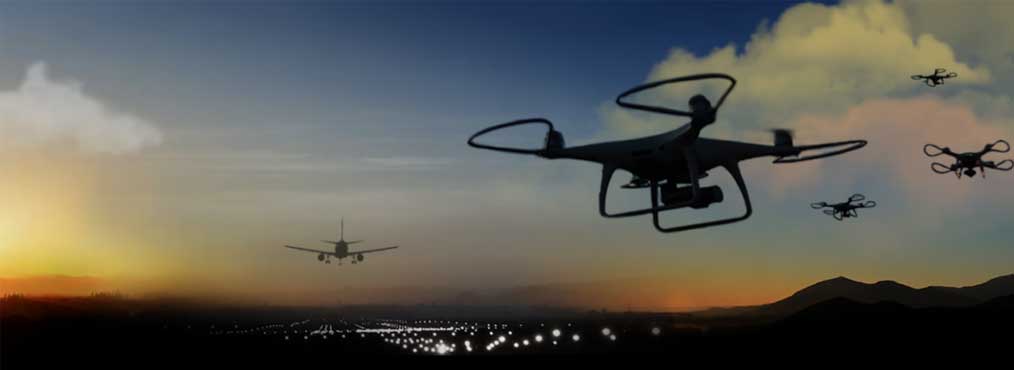
3 Key Trends in Unmanned Aerial Systems
In order to outpace and mitigate a growing threat, developers must embrace an open-architecture, modular and layered approach to any CUAS solution
 08-24-2023
08-24-2023
 Greg Fortier
Greg Fortier
 SYSTEMS ENGINEERING
SYSTEMS ENGINEERING
Key Takeaways:
- Unmanned aerial systems (UAS), or drones, are a growing security threat to multiple sectors around the world.
- Counter-unmanned aerial systems (CUAS) must match the diversity of UAS weaponization to defeat the threats.
- The most critical threat to solve is swarm attacks that attempt to overwhelm defenses with speed and volume.
LISTEN TO THIS BLOG:
The latest headlines about wide drone attacks being carried out in the Russia-Ukraine war underscore the proliferation and weaponization of unmanned aerial systems (UAS). Although UAS have brought new and innovative ways of doing things in the arts, sciences and even humanitarian work, they are producing new and unconventional threats in the hands of aggressors. We need to outpace them by developing counter-UAS, or CUAS, solutions for militaries and law enforcement agencies worldwide to mitigate UAS threats.
At a recent SAIC LinkedIn Live event, I sat down with defense industry analyst Brad Curran, Frost & Sullivan’s principal consultant for North America, to discuss this pressing issue in depth. Our discussion covered a broad range of topics and shed light on the many types of UAS threats, informing the audience of security challenges but also opportunities to counter them.
Here are the three key takeaways from our talk, which included SAIC’s approach to CUAS solutions development.
1. UAS-as-a-weapon is spreading fast
One of the major concerns we discussed was the rapid proliferation and weaponization of UAS. We are witnessing an exponential increase in their deployment, both in military conflicts and domestic security scenarios. In the Russia-Ukraine war, tens of thousands of UAS have already been utilized.
The weaponization of UAS and their widespread availability pose unprecedented challenges for defense and security forces. Their ability to swarm and conduct pervasive surveillance creates an advanced command-and-control network for adversaries, demanding robust CUAS solutions.
2. We need diverse application of CUAS
My talk with Curran highlighted the need for CUAS solutions across various domains, including the civilian sector, national security, critical infrastructure protection and defense establishments. Concurrent with UAS technology advances, adversaries are employing these systems for multiple and increasingly advanced purposes, ranging from reconnaissance to offensive actions.
As a result, CUAS solutions must be versatile and adaptable to fight the diverse threats UAS pose in different scenarios. SAIC’s CUAS approach emphasizes a modular and open systems architecture framework, allowing for quick integration of cutting-edge technologies from various partners to deliver tailored and scalable solutions for different applications.
3. Addressing swarm threats is a top priority
The most significant challenge in CUAS development is handling swarm attacks, where multiple UAS operate collectively to overwhelm traditional defense mechanisms. Industry research and development efforts must focus on detecting, identifying and engaging swarms effectively.
SAIC’s strength in solutions development lies in a technology-agnostic approach, fueled by partnerships and collaborations to harness the power of AI and automation for rapid decision-making. By integrating cutting-edge technologies and providing a wide range of solutions, SAIC aims to enhance the speed and accuracy of the kill chain for efficient mitigation of UAS threats.
The noteworthiness of these three trends is reinforced by current events in the news and the prioritization of effective CUAS across the U.S. government to respond to threats. It will require the incorporation of new technologies as they are developed, pointing to the advantage of an open-architecture, modular and layered approach to CUAS solutions.
At SAIC, we have designed, developed, tested and delivered a proven and award-winning CUAS system that can be tailored to a user’s mission and is both scalable and deployable. While the challenges will continue to be complex, I am confident that SAIC is well positioned to unleash the full potential of cutting-edge technologies to serve and protect our nation.
Watch the full discussion I had with Frost & Sullivan's Brad Curran at SAIC's LinkedIn Live event.
Learn more about SAIC's counter unmanned aerial systems solutions at our CUAS page.





